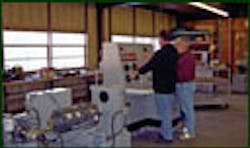Fuel Conservation
In today's environment of high fuel costs, the testing and detection of fuel leaks should be a priority.
The evolution of air transportation has brought inevitable change to the forefront of the aviation industry, complexities no longer belong to the mechanics and engineers of the field. Today's obstacles challenge economics.
Fuel conservation is becoming an important part of the revenue generating cycle in the aviation industry. According to the International Air Traffic Association, the increase of fuel prices contributed to profit losses for the industry around the globe. Especially for US Carriers, who lost more than $5 billion in 2004, despite a recent drop in oil prices. Standard & Poor's analysts also expect that 2005 will not boost high profits for the aviation sector.
And there is a cyclical effect that comes from rising petroleum costs which aid in higher ticket prices, fuel surcharges and increased labor disputes. While there are no immediate solutions considering the economic climate of the country, GSE specialis ts are designing, developing and thinking about equipment that can help further test the efficiencies of fuel components in air transportation vehicles. A New York based engineering firm (The James A. Staley Co.) has designed a Wing Leak Cavity Test Cart to assist GSE technicians with detecting fuel leaks in an airplane's wing cavity.
Developing a solution
A leading airframe manufacturer approached J.A.S.C.O. with the need for a piece of equipment to test fuel leaks on a plane's wing cavity. This particular piece was derived due to economic and environmental factors. Both factors were considered because jet petroleum is costly, and can also require careful treatment. After being approached, the proposal process took several weeks to determine which variables were most important for the creation of this piece of equipment.
Because the design process is the creative practice of identifying the exact need and devising a product to fulfill the need, certain variables were considered. Variables considered for this piece of equipment were portability, efficiency and safety for the operator and the aircraft, functional characteristics including a relatively simple way to test for leaks. Once those were identified through team discussions, consideration of specific materials and parts used to build the equipment were carefully itemized for a cost analysis. After the design and cost analysis were completed, ordering the parts and the actual assembling and building the cart from the blue prints begins in the shop.
Detecting a leak
The cart basically supplies either air pressure or a partial vacuum to one of the aircraft's dry fuel tanks and then precisely monitors any pressure changes occurring. Only very low amounts of either pressure or vacuum are used to avoid jeopardizing the aircraft's structural integrity. Two 6-inch dial compound gauges and a rate of climb indicator provide the means to accurately check pressure changes.
Operation of the cart is completely pneumatic, no electrical power is required. Facility shop air is simply hosed to the cart. A 60-foot coil of hose with quick-disconnects is stored on the cart for hook-up to the shop air. The inlet pressure gauge indicates the shop air supply pressure. Air is filtered and then sent to either a high volume reducing pressure regulator for pressurizing or to the vacuum generator for evacuating. Vacuum is created with an on-board ejector type vacuum pump.
A large diameter 50-foot long hose supplies the test tank with the pressure or vacuum from the cart. Monitoring the pressure or vacuum condition in the tank under test can be done with the cart's gauges. Note that the maximum pressure/vacuum applied to the tank should be ascertained from the airframe manufacturer before any testing is done. Any loss of pressure/vacuum can be noticed quickly with the rate of climb indicator. Fifty-foot hoses are also provided for the two gauges and the climb indicator.
In addition, a mixture of air and anhydrous ammonia can also be used when enhancement of leak detection is desired. Ammonia content of up to 12 percent can be used. Use can then be made of commercially available leak detectors. Most of these detectors are hand held units and have flexible probes that are ideal for passing along an aircraft skin with no physical contact. Materials used in the cart are compatible with the ammonia.
The cart structure is fabricated of stainless steel with an open lower section for hose storage. Swivel castors and push bar handles on each end allow maneuverability inside a hangar or on the ramp. Other characteristics include relief valves for both pressure and vacuum. The pressure relief valve is set at 6.5 psig and the vacuum relief valve is set at -4.5 psig. These valves should be set at the maximum tolerable levels of the airframe being tested to ensure that over-stressing can never occur.
With this, efficiency begins on the ground. Industry professionals in all positions need to align universal visions and goals for a safer, profitable industry for 2005.
Outlook for the future
As aviation and science progress, fuel will no longer be essential to flight. Space and air technology corporations are working on ways to make fuel cells or power generators combining hydrogen fuel with oxygen to produce electric power. GSE manufacturers are designing hybrid tow tractors. Designing equipment that works and helps people in industry is why we continue to work in this field. And technology will continually allow the field to break through barriers allowing the aviation industry to emerge victoriously.
But the emergence of the industry requires forward thinking solutions to help decrease some of the harsh economic factors. Undoubtedly, the field will progress and re-bound with the element of time. Aviation is resilient. It will seek and find ways to maintain its presence in the market. History teaches lessons. After all, The Wright Brothers taught us all a lesson or two in perseverance.
John Seeley is the Sr. Project Engineer for James A. Staley Company.
